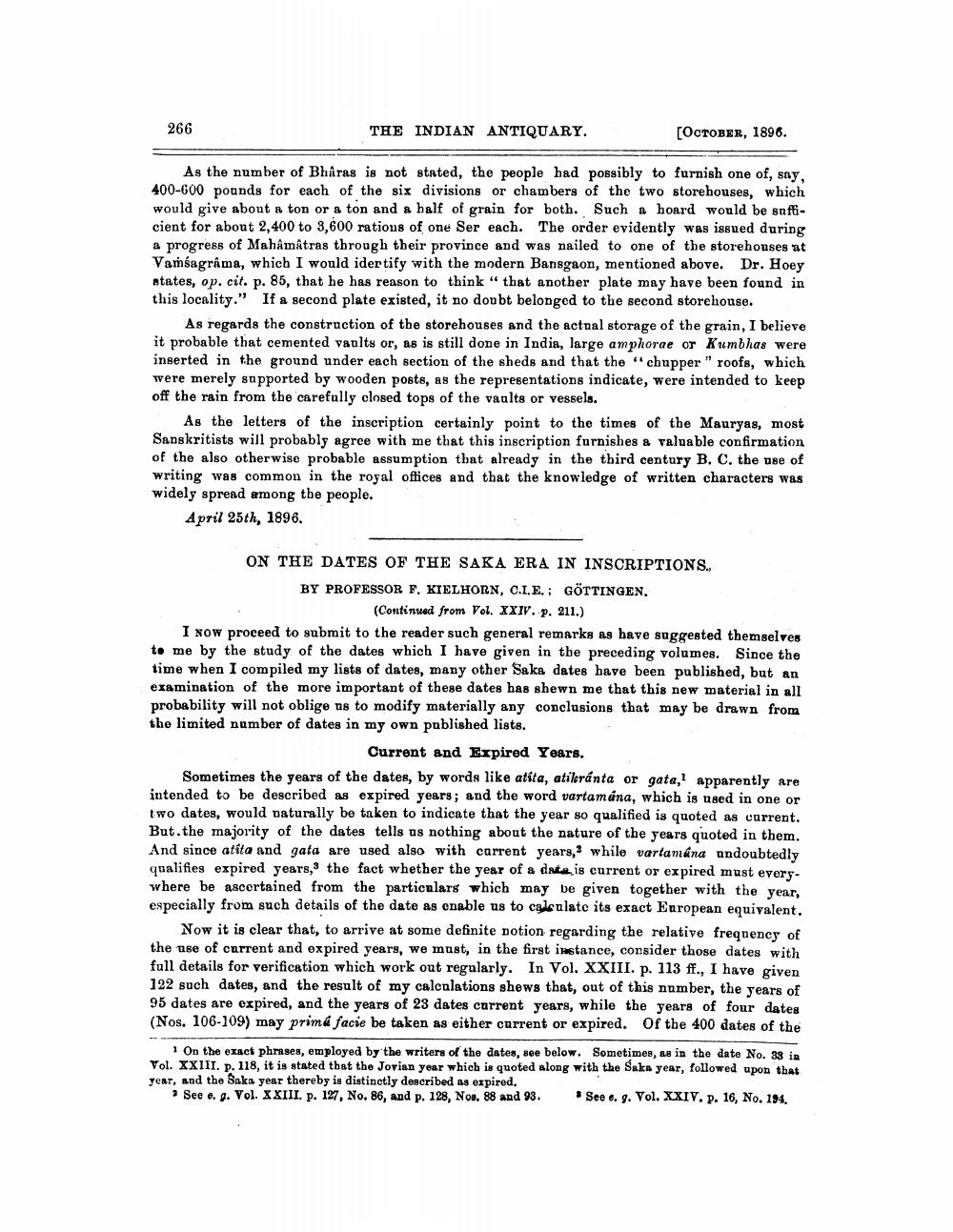________________
266
THE INDIAN ANTIQUARY.
[OCTOBER, 1896.
As the number of Bhâras is not stated, the people had possibly to furnish one of, say, 400-600 pounds for each of the six divisions or chambers of the two storehouses, which would give about a ton or a ton and a half of grain for both. Such a hoard would be safticient for about 2,400 to 3,600 rations of one Ser each. The order evidently was issued during a progress of Mahâmâtras through their province and was nailed to one of the storehouses at Vamśagrama, which I would idertify with the modern Bansgaon, mentioned above. Dr. Hoey states, op. cit. p. 85, that he has reason to think that another plate may have been found in this locality." If a second plate existed, it no doubt belonged to the second storehouse.
As regards the construction of the storehouses and the actual storage of the grain, I believe it probable that cemented vaults or, as is still done in India, large amphorae or Kumbhas were inserted in the ground under each section of the sheds and that the "chupper" roofs, which were merely supported by wooden posts, as the representations indicate, were intended to keep off the rain from the carefully closed tops of the vaults or vessels.
As the letters of the inscription certainly point to the times of the Mauryas, most Sanskritists will probably agree with me that this inscription furnishes & valuable confirmation of the also otherwise probable assumption that already in the third century B. C. the use of writing was common in the royal offices and that the knowledge of written characters was widely spread among the people.
April 25th, 1896.
ON THE DATES OF THE SAKA ERA IN INSCRIPTIONS. BY PROFESSOR F. KIELHORN, C.L.E.: GÖTTINGEN.
(Continued from Vol. XXIV. p. 211.) I now proceed to submit to the reader such general remarks as have suggested themselves to me by the study of the dates which I have given in the preceding volumes. Since the time when I compiled my lists of dates, many other Saka dates have been published, but an examination of the more important of these dates has shewn me that this new material in all probability will not oblige us to modify materially any conclusions that may be drawn from the limited number of dates in my own published lists.
Current and Expired Years. Sometimes the years of the dates, by words like atita, atileránta or gata, apparently are intended to be described as expired years; and the word vartamána, which is used in one or two dates, would naturally be taken to indicate that the year so qualified is quoted as current. But the majority of the dates tells us nothing about the nature of the years quoted in them. And since atita and gata are used also with corrent years, while vartamkna undoubtedly qualifies expired years, the fact whether the year of a data is current or expired must everywhere be ascertained from the particulars which may be given together with the year, especially from such details of the date as enable us to calculate its exact European equivalent.
Now it is clear that, to arrive at some definite notion regarding the relative frequency of the use of current and expired years, we must, in the first instance, consider those dates with full details for verification which work out regularly. In Vol. XXIII. p. 113 ff., I have given 122 such dates, and the result of my calcnlations shews that, out of this number, the years of 95 dates are expired, and the years of 23 dates current years, while the years of four dates (Nos. 106-109) may prima facie be taken as either current or expired. Of the 400 dates of the
On the exact phrases, employed by the writers of the dates, see below. Sometimes, as in the date No. 38 in Vol. XXIII. p. 118, it is stated that the Jovian year which is quoted along with the Saka year, followed upon that year, and the Saka year thereby is distinctly described as expired.
See e. g. Vol. XXIII. p. 127, No. 86, and p. 128, Nos. 88 and 93. See e. 9. Vol. XXIV. p. 16, No. 194.




